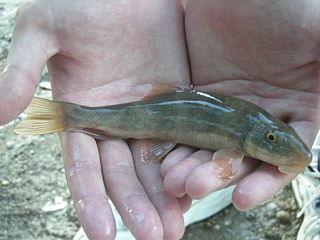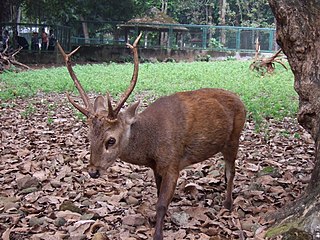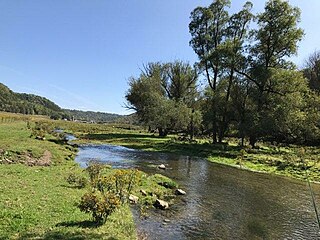
The Virgin River is a tributary of the Colorado River in the U.S. states of Utah, Nevada, and Arizona. The river is about 162 miles (261 km) long. It was designated Utah's first wild and scenic river in 2009, during the centennial celebration of Zion National Park.

The hog-nosed skunks belong to the genus Conepatus and are members of the family Mephitidae (skunks). They are native to the Americas. They have white backs and tails and black underparts.

Molina's hog-nosed skunk, also called the Andes skunk, is a skunk species from South America. It is found in Argentina, Bolivia, Brazil, Chile, Peru and Uruguay, at elevations up to 5000 m.

Sheep River Provincial Park is a provincial park located in Alberta, Canada, 23 kilometres (14 mi) west of Turner Valley on highway 546. It is part of the Kananaskis Country park system and encompasses a portion of the Sheep River valley.

Catostomus is a genus of fish belonging to the family Catostomidae, commonly known as suckers. Most members of the genus are native to North America, but C. catostomus is also found in Russia. Fish from different species of the genus are known to readily hybridize with each other.

The northern hogsucker is a freshwater ray-finned fish belonging to the family Catostomidae, the suckers. It is native to the United States and Canada where it is found in streams and rivers. It prefers clear, fast-flowing water, where it can forage on the riverbed for crustaceans, mollusks, aquatic insects, algae and detritus. It turns over small pebbles and scrapes materials off rocks and sucks up the particles, and other species of fish sometimes station themselves downstream from its activities so as to garner disturbed food fragments. Breeding takes place on gravel bottoms in shallow riffles in late spring. This fish is susceptible to such man-made disturbances as channelization, sedimentation, pollution, and dam construction. However, it has a wide range and is a common species so the International Union for Conservation of Nature has rated its conservation status as being of "least concern".

The Park River, sometimes called the Hog River, is a tributary of the Connecticut River in the city of Hartford, Connecticut. Between 1940 and the 1980s, the 2.3-mile (3.7 km) river was buried by the Army Corps of Engineers to prevent the spring floods regularly caused by increased surface runoff from urban development.
"Let's Take It to the Stage" is a song by Funkadelic, the title track to their 1975 album Let's Take It to the Stage. It was written by George Clinton, Bootsy Collins and Garry Shider, with lead vocals by Clinton. The lyrics consist of mockery of other popular bands, risqué nursery rhymes, and stream-of-consciousness-style rapping.

The American hog-nosed skunk is a species of hog-nosed skunk from Central and North America, and is one of the largest skunks in the world, growing to lengths of up to 2.7 feet (82 cm). Recent work has concluded the western hog-nosed skunk is the same species, and Conepatus leuconotus is the correct name of the merged populations.

The Bawean deer, also known as Kuhl's hog deer or Bawean hog deer, is a highly threatened species of deer endemic to the island of Bawean in Indonesia. Due to ongoing habitat loss, small population size and limited range, the Bawean deer is evaluated as critically endangered on the IUCN Red List of Threatened Species. It is listed on Appendix I of CITES. It has few natural enemies except for birds of prey and large snakes such as pythons.

The Catostomidae are the suckers of the order Cypriniformes, with about 78 species in this family of freshwater fishes. The Catostomidae are almost exclusively native to North America. The only exceptions are Catostomus catostomus, found in both North America and Russia, and Myxocyprinus asiaticus found only in China. In the Ozarks they are a common food fish and a festival is held each year to celebrate them. Ictiobus cyprinellus can reach an age up to 112 years, making it the oldest known freshwater teleost.

The Alabama hog sucker is a species of fish in the family Catostomidae, the suckers. It is native to several river systems in the southeastern United States. Its range includes much of the state of Alabama and extends into parts of Mississippi, Tennessee, and Georgia.
The neon flying squid, sometimes called the red flying squid, akaika, and red squid is a species of large flying squid in the family Ommastrephidae. They are found in subtropical and temperate oceanic waters globally.

A sucker in zoology refers to a specialised attachment organ of an animal. It acts as an adhesion device in parasitic worms, several flatworms, cephalopods, certain fishes, amphibians, and bats. It is a muscular structure for suction on a host or substrate. In parasitic annelids, flatworms and roundworms, suckers are the organs of attachment to the host tissues. In tapeworms and flukes, they are a parasitic adaptation for attachment on the internal tissues of the host, such as intestines and blood vessels. In roundworms and flatworms they serve as attachment between individuals particularly during mating. In annelids, a sucker can be both a functional mouth and a locomotory organ. The structure and number of suckers are often used as basic taxonomic diagnosis between different species, since they are unique in each species. In tapeworms there are two distinct classes of suckers, namely "bothridia" for true suckers, and "bothria" for false suckers. In digeneal flukes there are usually an oral sucker at the mouth and a ventral sucker posterior to the mouth. Roundworms have their sucker just in front of the anus; hence it is often called a pre-anal sucker.

The white sucker is a freshwater cypriniform fish inhabiting the upper Midwest and Northeast in North America, but is also found as far south as Georgia and New Mexico in the south and west. The fish is commonly known as a "sucker" due to its fleshy, papillose lips that suck up organic matter and aufwuchs from the bottom of rivers and streams.
Rush Creek is a stream in Fillmore and Winona counties, in the U.S. state of Minnesota. It is a tributary of the Root River, which it joins in Rushford, Minnesota.

The Roanoke hogsucker is a freshwater ray-finned fish found in the upper and middle Roanoke River basin in North Carolina and Virginia. It is very similar to and lives in the same area as the northern hogsucker. They are in the sucker family, Catostomidae. Many anglers enjoy catching them due to their ability to put up a good fight. They are not considered a game fish and are considered significantly rare due to their limited distribution.

Pine Creek is a stream in Fillmore and Winona counties, in the U.S. state of Minnesota. It is a tributary of the Rush Creek, which is a tributary of the Root River. It joins the Rush Creek in the extreme north of Rushford, Minnesota. Tributaries of Pine Creek are Cooledge Creek and Hemmingway Creek.

Hog badgers are three species of mustelid in the genus Arctonyx. They represent one of the two genera in the subfamily Melinae, alongside the true badgers.














